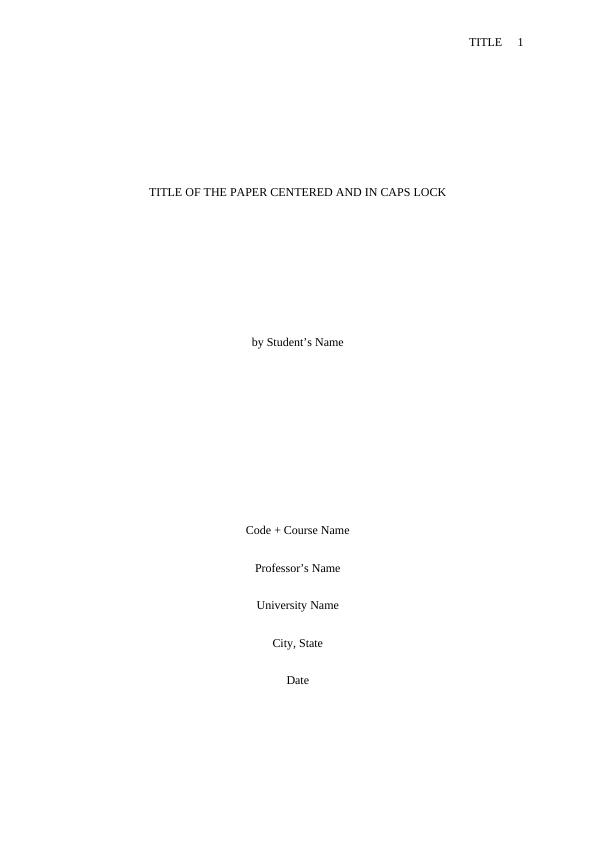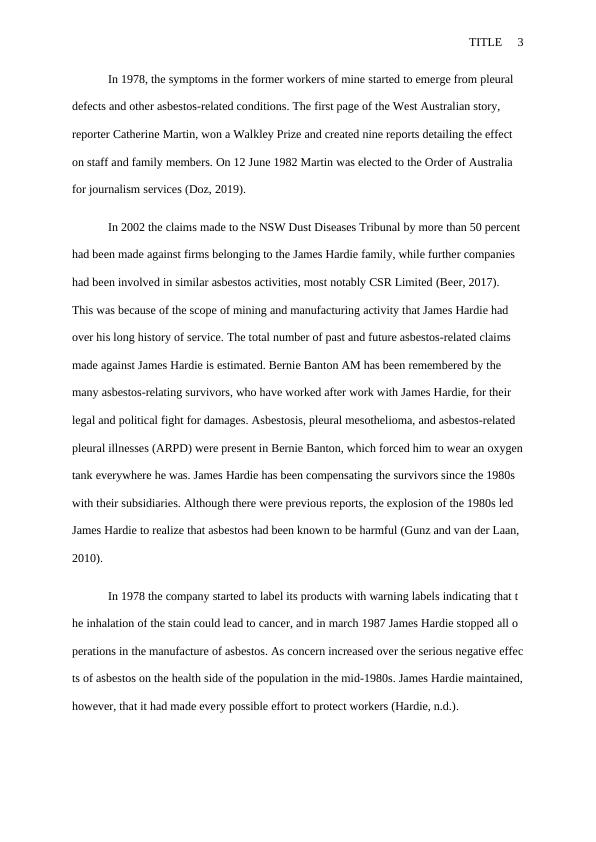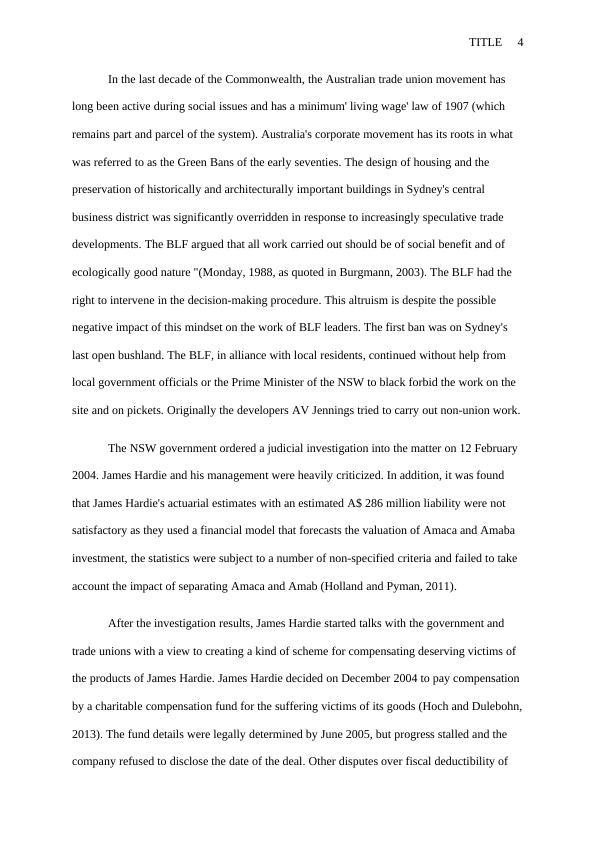James Hardie Industries: A Case Study on Asbestos-Related Claims and Compensation
Added on 2022-11-19
13 Pages3439 Words277 Views
TITLE 1
TITLE OF THE PAPER CENTERED AND IN CAPS LOCK
by Student’s Name
Code + Course Name
Professor’s Name
University Name
City, State
Date
TITLE OF THE PAPER CENTERED AND IN CAPS LOCK
by Student’s Name
Code + Course Name
Professor’s Name
University Name
City, State
Date

TITLE 2
Introduction
Hardie industries plc Jan. Is an industrial construction materials firm based in Ireland which
is a specialty business in fiber cement products listed on the Australian stock exchange?
James Hardie produces and develops technology, materials, and processes for the
manufacture of construction materials. Hardie has also been running an R&D facility
dedicated solely to fiber cement manufacturing for over 20 years. Working with asbestos-
containing products–including the construction material known as fibro or fibrositis–has
resulted in people developing multiple pleural disorders, including asbestosis and malignant
mesothelioma. In May 2012, the Australian High Court ruled that seven former non-
executive directors of James Hardie had deceived bourses on the compensation fund for
asbestos victims. James Hardie emigrated from Linlithgow, Scotland, to Australia in 1888
and established an enterprise importing oils and animal hides. Andrew Reid, from Linlithgow
too, came and was a full partner in 1895 to join Hardie in Melbourne. After Hardie retired in
1911, his half-sales firm was sold to Reid. In 1951 the first Australian stock listed became
James Hardie Industries Ltd. For the most part of the 20th century, James Hardie was the
leading producer in Australia in the production of asbestos concrete sheets and associated
building products that used the material for reinforcement by asbestos.
Discussion
The investors of the group voted unanimity in December 2001 to restructure and move the
company as a parent company in the Netherlands. This was part of a strategy to free the firm
from the stigmata of its asbestos liabilities (Ahammad, Glaister and Gomes, 2019). The
agreement to make James Hardie an Irish Firm of Societies Europe, on 19 February 2010 and
James Hardie Industries NV became James Hardie Industries SE, were transferring their
corporate domicile from the Netherlands to Ireland.
Introduction
Hardie industries plc Jan. Is an industrial construction materials firm based in Ireland which
is a specialty business in fiber cement products listed on the Australian stock exchange?
James Hardie produces and develops technology, materials, and processes for the
manufacture of construction materials. Hardie has also been running an R&D facility
dedicated solely to fiber cement manufacturing for over 20 years. Working with asbestos-
containing products–including the construction material known as fibro or fibrositis–has
resulted in people developing multiple pleural disorders, including asbestosis and malignant
mesothelioma. In May 2012, the Australian High Court ruled that seven former non-
executive directors of James Hardie had deceived bourses on the compensation fund for
asbestos victims. James Hardie emigrated from Linlithgow, Scotland, to Australia in 1888
and established an enterprise importing oils and animal hides. Andrew Reid, from Linlithgow
too, came and was a full partner in 1895 to join Hardie in Melbourne. After Hardie retired in
1911, his half-sales firm was sold to Reid. In 1951 the first Australian stock listed became
James Hardie Industries Ltd. For the most part of the 20th century, James Hardie was the
leading producer in Australia in the production of asbestos concrete sheets and associated
building products that used the material for reinforcement by asbestos.
Discussion
The investors of the group voted unanimity in December 2001 to restructure and move the
company as a parent company in the Netherlands. This was part of a strategy to free the firm
from the stigmata of its asbestos liabilities (Ahammad, Glaister and Gomes, 2019). The
agreement to make James Hardie an Irish Firm of Societies Europe, on 19 February 2010 and
James Hardie Industries NV became James Hardie Industries SE, were transferring their
corporate domicile from the Netherlands to Ireland.

TITLE 3
In 1978, the symptoms in the former workers of mine started to emerge from pleural
defects and other asbestos-related conditions. The first page of the West Australian story,
reporter Catherine Martin, won a Walkley Prize and created nine reports detailing the effect
on staff and family members. On 12 June 1982 Martin was elected to the Order of Australia
for journalism services (Doz, 2019).
In 2002 the claims made to the NSW Dust Diseases Tribunal by more than 50 percent
had been made against firms belonging to the James Hardie family, while further companies
had been involved in similar asbestos activities, most notably CSR Limited (Beer, 2017).
This was because of the scope of mining and manufacturing activity that James Hardie had
over his long history of service. The total number of past and future asbestos-related claims
made against James Hardie is estimated. Bernie Banton AM has been remembered by the
many asbestos-relating survivors, who have worked after work with James Hardie, for their
legal and political fight for damages. Asbestosis, pleural mesothelioma, and asbestos-related
pleural illnesses (ARPD) were present in Bernie Banton, which forced him to wear an oxygen
tank everywhere he was. James Hardie has been compensating the survivors since the 1980s
with their subsidiaries. Although there were previous reports, the explosion of the 1980s led
James Hardie to realize that asbestos had been known to be harmful (Gunz and van der Laan,
2010).
In 1978 the company started to label its products with warning labels indicating that t
he inhalation of the stain could lead to cancer, and in march 1987 James Hardie stopped all o
perations in the manufacture of asbestos. As concern increased over the serious negative effec
ts of asbestos on the health side of the population in the mid-1980s. James Hardie maintained,
however, that it had made every possible effort to protect workers (Hardie, n.d.).
In 1978, the symptoms in the former workers of mine started to emerge from pleural
defects and other asbestos-related conditions. The first page of the West Australian story,
reporter Catherine Martin, won a Walkley Prize and created nine reports detailing the effect
on staff and family members. On 12 June 1982 Martin was elected to the Order of Australia
for journalism services (Doz, 2019).
In 2002 the claims made to the NSW Dust Diseases Tribunal by more than 50 percent
had been made against firms belonging to the James Hardie family, while further companies
had been involved in similar asbestos activities, most notably CSR Limited (Beer, 2017).
This was because of the scope of mining and manufacturing activity that James Hardie had
over his long history of service. The total number of past and future asbestos-related claims
made against James Hardie is estimated. Bernie Banton AM has been remembered by the
many asbestos-relating survivors, who have worked after work with James Hardie, for their
legal and political fight for damages. Asbestosis, pleural mesothelioma, and asbestos-related
pleural illnesses (ARPD) were present in Bernie Banton, which forced him to wear an oxygen
tank everywhere he was. James Hardie has been compensating the survivors since the 1980s
with their subsidiaries. Although there were previous reports, the explosion of the 1980s led
James Hardie to realize that asbestos had been known to be harmful (Gunz and van der Laan,
2010).
In 1978 the company started to label its products with warning labels indicating that t
he inhalation of the stain could lead to cancer, and in march 1987 James Hardie stopped all o
perations in the manufacture of asbestos. As concern increased over the serious negative effec
ts of asbestos on the health side of the population in the mid-1980s. James Hardie maintained,
however, that it had made every possible effort to protect workers (Hardie, n.d.).

TITLE 4
In the last decade of the Commonwealth, the Australian trade union movement has
long been active during social issues and has a minimum' living wage' law of 1907 (which
remains part and parcel of the system). Australia's corporate movement has its roots in what
was referred to as the Green Bans of the early seventies. The design of housing and the
preservation of historically and architecturally important buildings in Sydney's central
business district was significantly overridden in response to increasingly speculative trade
developments. The BLF argued that all work carried out should be of social benefit and of
ecologically good nature "(Monday, 1988, as quoted in Burgmann, 2003). The BLF had the
right to intervene in the decision-making procedure. This altruism is despite the possible
negative impact of this mindset on the work of BLF leaders. The first ban was on Sydney's
last open bushland. The BLF, in alliance with local residents, continued without help from
local government officials or the Prime Minister of the NSW to black forbid the work on the
site and on pickets. Originally the developers AV Jennings tried to carry out non-union work.
The NSW government ordered a judicial investigation into the matter on 12 February
2004. James Hardie and his management were heavily criticized. In addition, it was found
that James Hardie's actuarial estimates with an estimated A$ 286 million liability were not
satisfactory as they used a financial model that forecasts the valuation of Amaca and Amaba
investment, the statistics were subject to a number of non-specified criteria and failed to take
account the impact of separating Amaca and Amab (Holland and Pyman, 2011).
After the investigation results, James Hardie started talks with the government and
trade unions with a view to creating a kind of scheme for compensating deserving victims of
the products of James Hardie. James Hardie decided on December 2004 to pay compensation
by a charitable compensation fund for the suffering victims of its goods (Hoch and Dulebohn,
2013). The fund details were legally determined by June 2005, but progress stalled and the
company refused to disclose the date of the deal. Other disputes over fiscal deductibility of
In the last decade of the Commonwealth, the Australian trade union movement has
long been active during social issues and has a minimum' living wage' law of 1907 (which
remains part and parcel of the system). Australia's corporate movement has its roots in what
was referred to as the Green Bans of the early seventies. The design of housing and the
preservation of historically and architecturally important buildings in Sydney's central
business district was significantly overridden in response to increasingly speculative trade
developments. The BLF argued that all work carried out should be of social benefit and of
ecologically good nature "(Monday, 1988, as quoted in Burgmann, 2003). The BLF had the
right to intervene in the decision-making procedure. This altruism is despite the possible
negative impact of this mindset on the work of BLF leaders. The first ban was on Sydney's
last open bushland. The BLF, in alliance with local residents, continued without help from
local government officials or the Prime Minister of the NSW to black forbid the work on the
site and on pickets. Originally the developers AV Jennings tried to carry out non-union work.
The NSW government ordered a judicial investigation into the matter on 12 February
2004. James Hardie and his management were heavily criticized. In addition, it was found
that James Hardie's actuarial estimates with an estimated A$ 286 million liability were not
satisfactory as they used a financial model that forecasts the valuation of Amaca and Amaba
investment, the statistics were subject to a number of non-specified criteria and failed to take
account the impact of separating Amaca and Amab (Holland and Pyman, 2011).
After the investigation results, James Hardie started talks with the government and
trade unions with a view to creating a kind of scheme for compensating deserving victims of
the products of James Hardie. James Hardie decided on December 2004 to pay compensation
by a charitable compensation fund for the suffering victims of its goods (Hoch and Dulebohn,
2013). The fund details were legally determined by June 2005, but progress stalled and the
company refused to disclose the date of the deal. Other disputes over fiscal deductibility of

End of preview
Want to access all the pages? Upload your documents or become a member.
Related Documents
Assignment on Management Lawlg...
|5
|1120
|62
James Hardie: Restructuring, removing and reviewing the social contractlg...
|11
|2409
|401
Legal, Ethical and Governance Issues in the James Hardie Asbestos Scandallg...
|13
|3825
|32
Business and Corporate Law | Reportlg...
|8
|2505
|72
